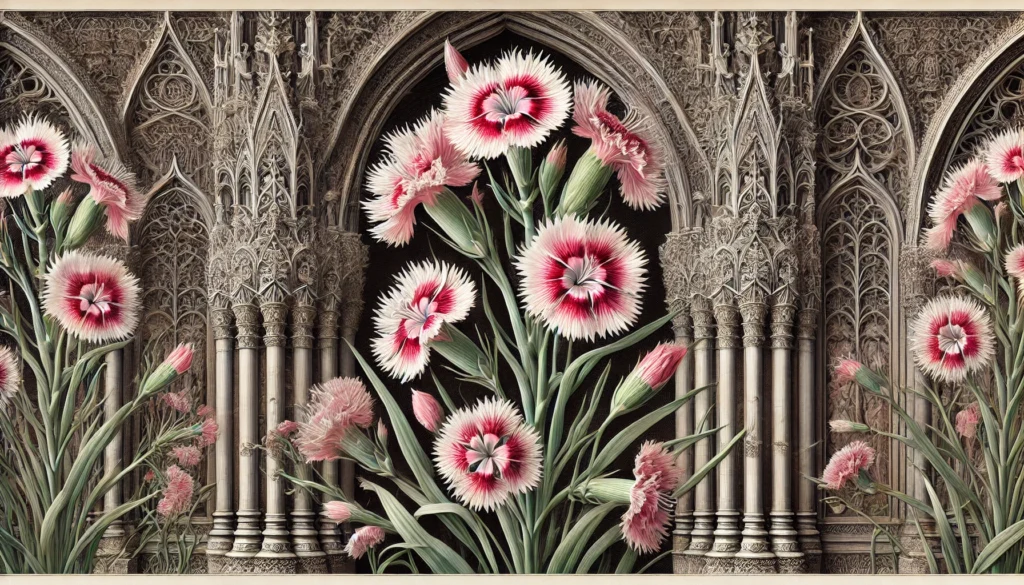

Home » Cat Plants » Is Your Cat at Risk from Wild Carnation Plant?

Carnations (Dianthus caryophyllus), also known as Pinks or Sweet William, are mildly toxic to cats. These flowering plants, native to the Mediterranean region, are now cultivated worldwide for their attractive blooms.
While not severely poisonous, ingesting any part of the carnation plant can lead to mild to moderate symptoms in cats. Carnations contain an unknown irritant that can cause gastrointestinal upset and dermatitis in felines.
Ingestion may cause mild gastrointestinal upset, but is generally not life-threatening.
Ingestion can result in mild symptoms like vomiting, diarrhea, or drooling. Rarely fatal but may require veterinary care.
Eating these plants can lead to more pronounced symptoms like abdominal pain, lethargy, or difficulty breathing. Veterinary intervention may be necessary.
Ingesting even small amounts can cause severe symptoms like organ damage, seizures, or cardiac failure without rapid treatment.
All parts of these plants are extremely poisonous to cats and can quickly lead to death, even with immediate veterinary care.
** Please note: Please note that toxicity level can vary based on the amount ingested and the specific cat. It's always best to keep these plants completely inaccessible to cats and seek immediate veterinary care or call the poison hotline if you suspect your cat has ingested any part of a toxic plant.
If your cat has ingested any part of a carnation plant, they may exhibit various symptoms indicating mild to moderate poisoning. These symptoms can appear within a few hours of ingestion and may last for several hours to a couple of days.Common symptoms of carnation poisoning in cats include:
If you suspect your cat has ingested a carnation plant, it is essential to seek veterinary care promptly. Your veterinarian will perform a thorough examination and may recommend the following diagnostic steps:
Based on the examination and test results, your veterinarian will provide an appropriate treatment plan to manage your cat’s symptoms and support their recovery.

A: Yes, the Wild Carnation plant is harmful to cats. It contains toxic compounds that can cause mild gastrointestinal upset and skin irritation if ingested or touched.
A: Symptoms of Wild Carnation poisoning in cats include vomiting, drooling, and skin irritation. If your cat shows any of these signs, seek veterinary care immediately.
A: The Wild Carnation plant is mildly toxic to pets, particularly cats and dogs. Ingestion can lead to digestive issues, but severe reactions are uncommon.
A: Cats can recover from Wild Carnation plant poisoning with appropriate treatment. Most cases resolve quickly with supportive care, but monitoring your cat is important.
A: It is not entirely safe to have a Wild Carnation plant in a home with cats due to its mild toxicity. Consider safer alternatives like Spider plants or Boston ferns for a cat-friendly environment.
A: If your cat ingests a Wild Carnation plant, observe them closely for any signs of distress and contact your veterinarian. Early intervention can help manage any symptoms and prevent complications.
Carnations have a rich history dating back over 2,000 years. The ancient Greeks and Romans cultivated these flowers for their beauty and fragrance, using them in ceremonial crowns and festivities. The name “carnation” is believed to derive from the Latin word “coronation,” meaning a crown or garland.
As carnation cultivation spread throughout Europe and Asia, the flowers gained symbolic meanings in various cultures. In the Middle Ages, carnations appeared in religious iconography and artwork. By the Renaissance, selective breeding had begun, leading to the development of the diverse colors and forms we see today.
Carnations were introduced to the Americas by European settlers and quickly became popular in gardens across the New World. Today, carnations are widely cultivated and appreciated for their aesthetic beauty, fragrance, and symbolic significance in many cultures worldwide.
Please note: The information shared in this post is for informational purposes only and should not be considered as veterinary medical advice.
🐾 A hilarious or heart-melting cat video
🐾 Our latest paws-on review of a cool cat toy